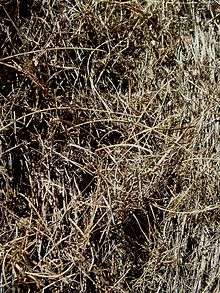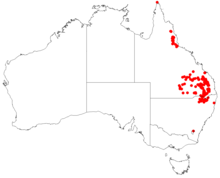Allocasuarina inophloia
Allocasuarina inophloia, also known as woolly oak,[1] or stringybark she-oak, is a shrub or small tree of the she-oak family Casuarinaceae endemic to inland New South Wales and Queensland. The hairy bark is an unusual feature.
| Stringybark she-oak | |
|---|---|
 | |
| Bark | |
| Scientific classification | |
| Kingdom: | Plantae |
| Clade: | Tracheophytes |
| Clade: | Angiosperms |
| Clade: | Eudicots |
| Clade: | Rosids |
| Order: | Fagales |
| Family: | Casuarinaceae |
| Genus: | Allocasuarina |
| Species: | A. inophloia |
| Binomial name | |
| Allocasuarina inophloia | |
 | |
| Occurrence data from AVH | |
Taxonomy
First collected near Roma in central Queensland, the stringybark she-oak was described by Ferdinand von Mueller and Frederick Manson Bailey in 1882 as Casuarina inophloia.[2] Exactly 100 years later, Lawrie Johnson moved it to its current genus Allocasuarina in his revision of the she-oaks.[3]
Description
Allocasuarina inophloia grows as a small tree with an open habit ranging from 3 to 10 metres (10 to 33 ft) high. It is dioecious.[4] Like all she-oaks, its foliage is composed of segmented branchlets with segments known as articles, its leaves reduced to tiny scales between them.[5]
Distribution and habitat
In New South Wales it occurs in areas such as the Clarence River valley, Emmaville, Yetman,[4] south to Waralda, while it ranges in Queensland north to Herberton.[6] It is found in woodland on sandstone, ironstone or laterite ridges.[4][6] Associated species include grasstrees (Xanthorrhoea) and eucalypts, such as drooping ironbark (Eucalyptus caleyi).[7]
Northwest of Glen Innes it is found in tall scrub on granitic soil uplands with other dominant species such as the she-oak species Allocasuarina brachystachya, wattle species Acacia williamsiana and the endangered Severn River heath-myrtle (Micromyrtus grandis) and understory shrubs such as Leucopogon neo-anglicus and fringe myrtle (Calytrix tetragona).[7]
It has been recorded as a host plant for the orange mistletoe (Dendrophthoe glabrescens).[8]
Cultivation
Its shaggy bark gives the species its horticultural potential. It is frost hardy and able to tolerate poor soils.[5]
References
- "Allocasuarina monilifera - Casuarinaceae Necklace sheoak". Australian Plants Society Tasmania Inc. Archived from the original on 14 January 2017. Retrieved 12 January 2017.
- "Casuarina inophloia F.Muell. & F.M.Bailey". Australian Plant Name Index (APNI), IBIS database. Centre for Plant Biodiversity Research, Australian Government.
- "Allocasuarina inophloia (F.Muell. & F.M.Bailey) L.A.S.Johnson". Australian Plant Name Index (APNI), IBIS database. Centre for Plant Biodiversity Research, Australian Government.
- "Plant Net - New South Wales Flora Online". Allocasuarina inophloia. NSW Government. Retrieved January 11, 2012.
- Ahrendt, Lucy (2006). "Allocasuarina inophloia". Growing Native Plants. Canberra, Australian Capital Territory: Australian National Botanic Gardens, Australian Government. Retrieved 12 January 2012.
- "Allocasuarina inophloia (F.Muell. & F.M.Bailey) L.A.S.Johnson". Flora of Australia Online. Department of the Environment and Heritage, Australian Government.
- Hunter, John T.; Clark, Peter J. (1998). "The vegetation of granitic outcrop communities on the New England Batholith of eastern Australia" (PDF). Cunninghamia. 5 (3): 547–618. Archived from the original (PDF) on 2014-06-24.
- Downey, Paul O. (1998). "An inventory of host species for each aerial mistletoe species (Loranthaceae and Viscaceae) in Australia" (PDF). Cunninghamia. 5 (3): 685–720. Archived from the original (PDF) on 2013-04-25.